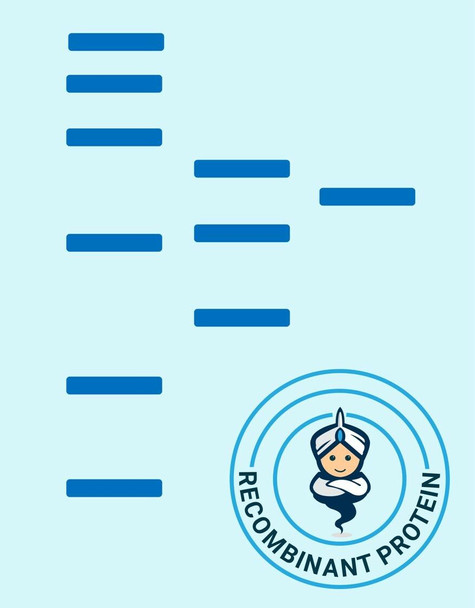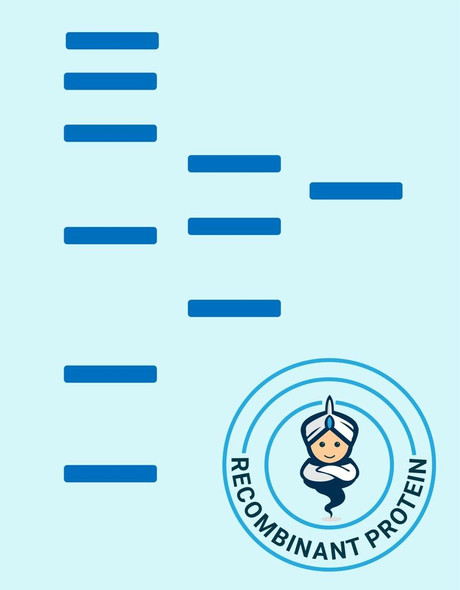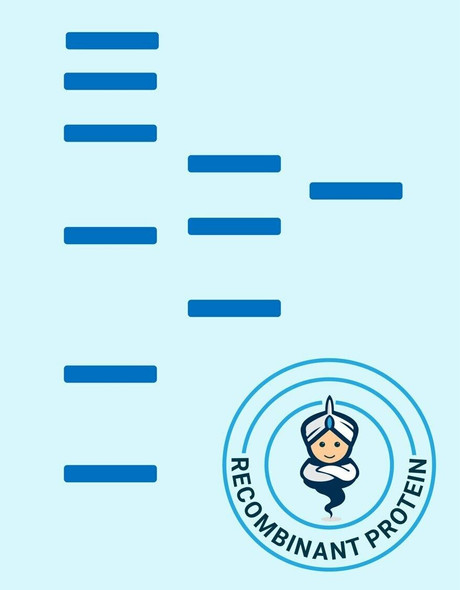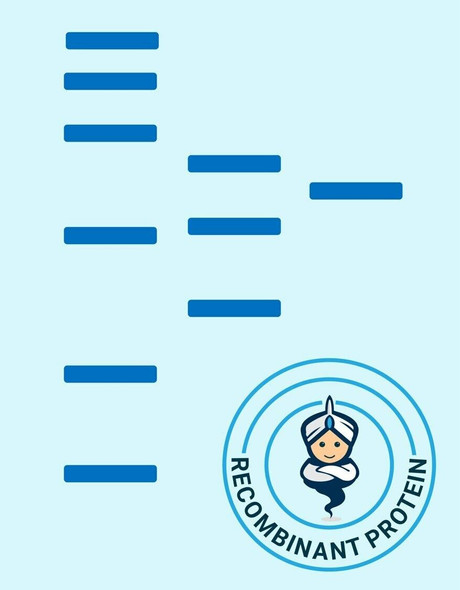Human KGF 2 His Recombinant Protein (RPPB0699)
- SKU:
- RPPB0699
- Product type:
- Recombinant Protein
- Size:
- 10ug
- Species:
- Human
- Target:
- KGF 2 His
- Synonyms:
- FGFA
- FGF10
- FGF-10
- KGF-2
- Source:
- Escherichia Coli
- Uniprot:
- O15520
Description
| Product Name: | Human KGF 2 His Recombinant Protein |
| Product Code: | RPPB0699 |
| Size: | 10µg |
| Species: | Human |
| Target: | KGF 2 His |
| Synonyms: | FGFA, FGF10, FGF-10, KGF-2, Fibroblast growth factor 10. |
| Source: | Escherichia Coli |
| Physical Appearance: | Sterile Filtered colorless solution. |
| Formulation: | The KGF 2 solution (0.25mg/ml) contains 20mM Tris-HCl buffer (pH 8.0), 200mM NaCl 2mM DTT, 2mM EDTA and 50% glycerol. |
| Stability: | Store at 4°C if entire vial will be used within 2-4 weeks. Store, frozen at -20°C for longer periods of time. For long term storage it is recommended to add a carrier protein (0.1% HSA or BSA).Avoid multiple freeze-thaw cycles. |
| Purity: | Greater than 95% as determined by SDS-PAGE. |
| Amino Acid Sequence: | MGSSHHHHHH SSGLVPRGSH MGSHMQALGQ DMVSPEATNS SSSSFSSPSS AGRHVRSYNH LQGDVRWRKL FSFTKYFLKI EKNGKVSGTK KENCPYSILE ITSVEIGVVA VKAINSNYYL AMNKKGKLYG SKEFNNDCKL KERIEENGYN TYASFNWQHN GRQMYVALNG KGAPRRGQKT RRKNTSAHFL PMVVHS |
KGF-2 is a member of the fibroblast growth factor (FGF) family. FGF family members possess broad mitogenic and cell survival activities, and are involved in a variety of biological processes, including embryonic development, cell growth, morphogenesis, tissue repair, tumor growth and invasion. FGF-10 exhibits mitogenic activity for keratinizing epidermal cells, but essentially no activity for fibroblasts, which is similar to the biological activity of FGF7. Studies of the mouse homolog of suggested that this gene is required for embryonic epidermal morphogenesis including brain development, lung morphogenesis, and initiation of lim bud formation. This gene is also implicated to be a primary factor in the process of wound healing.
KGF 2 Human Recombinant produced in E.coli is a single, non-glycosylated polypeptide chain containing 196 amino acids (38-208) and having a molecular mass of 22.0kDa.KGF 2 is fused to a 25 amino acid His-tag at N-terminus & purified by proprietary chromatographic techniques.
| UniProt Protein Function: | FGF10: Plays an important role in the regulation of embryonic development, cell proliferation and cell differentiation. Required for normal branching morphogenesis. May play a role in wound healing. Interacts with FGFR1 and FGFR2. Interacts with FGFBP1. Belongs to the heparin-binding growth factors family. |
| UniProt Protein Details: | Protein type:Secreted; Cytokine; Cell development/differentiation; Secreted, signal peptide; Motility/polarity/chemotaxis Chromosomal Location of Human Ortholog: 5p13-p12 Cellular Component: extracellular matrix; extracellular space; cell surface; plasma membrane; extracellular region; nucleus Molecular Function:heparin binding; protein binding; growth factor activity; type 2 fibroblast growth factor receptor binding; chemoattractant activity; fibroblast growth factor receptor binding Biological Process: nerve growth factor receptor signaling pathway; salivary gland development; activation of MAPK activity; somatic stem cell maintenance; urothelial cell proliferation; positive regulation of epithelial cell proliferation involved in wound healing; positive regulation of transcription, DNA-dependent; muscle cell fate commitment; response to lipopolysaccharide; regulation of saliva secretion; embryonic pattern specification; G1/S-specific positive regulation of cyclin-dependent protein kinase activity; positive regulation of fibroblast proliferation; epithelial cell proliferation; positive chemotaxis; embryonic digestive tract morphogenesis; induction of an organ; mesonephros development; embryonic genitalia morphogenesis; spleen development; positive regulation of keratinocyte migration; fibroblast growth factor receptor signaling pathway; positive regulation of DNA repair; positive regulation of urothelial cell proliferation; positive regulation of peptidyl-tyrosine phosphorylation; branching morphogenesis of a tube; positive regulation of transcription from RNA polymerase II promoter; smooth muscle cell differentiation; determination of left/right symmetry; metanephros development; positive regulation of epithelial cell proliferation; wound healing; radial glial cell differentiation; positive regulation of mitotic cell cycle; positive regulation of vascular endothelial growth factor receptor signaling pathway; response to estradiol stimulus; induction of positive chemotaxis; negative regulation of cell proliferation; establishment of mitotic spindle orientation; positive regulation of MAPKKK cascade; tissue regeneration; positive regulation of lymphocyte proliferation; pancreas development; male genitalia morphogenesis; thyroid gland development; angiogenesis; lacrimal gland development; otic vesicle formation; female genitalia morphogenesis; positive regulation of Notch signaling pathway; epidermal growth factor receptor signaling pathway; hair follicle morphogenesis; phosphoinositide-mediated signaling; thymus development; keratinocyte proliferation; regulation of activin receptor signaling pathway; embryonic camera-type eye development; odontogenesis of dentine-containing teeth; limb bud formation; pituitary gland development; positive regulation of ATPase activity; actin cytoskeleton reorganization; white fat cell differentiation; insulin receptor signaling pathway; innate immune response; blood vessel remodeling; positive regulation of Ras protein signal transduction; positive regulation of DNA replication; regulation of smoothened signaling pathway Disease: Lacrimoauriculodentodigital Syndrome; Aplasia Of Lacrimal And Salivary Glands |
| NCBI Summary: | The protein encoded by this gene is a member of the fibroblast growth factor (FGF) family. FGF family members possess broad mitogenic and cell survival activities, and are involved in a variety of biological processes, including embryonic development, cell growth, morphogenesis, tissue repair, tumor growth and invasion. This protein exhibits mitogenic activity for keratinizing epidermal cells, but essentially no activity for fibroblasts, which is similar to the biological activity of FGF7. Studies of the mouse homolog of suggested that this gene is required for embryonic epidermal morphogenesis including brain development, lung morphogenesis, and initiation of lim bud formation. This gene is also implicated to be a primary factor in the process of wound healing. [provided by RefSeq, Jul 2008] |
| UniProt Code: | O15520 |
| NCBI GenInfo Identifier: | 6015141 |
| NCBI Gene ID: | 2255 |
| NCBI Accession: | O15520.1 |
| UniProt Secondary Accession: | O15520,Q6FHR3, Q6FHT6, Q96P59, C7FDY0, |
| UniProt Related Accession: | O15520 |
| Molecular Weight: | 208 |
| NCBI Full Name: | Fibroblast growth factor 10 |
| NCBI Synonym Full Names: | fibroblast growth factor 10 |
| NCBI Official Symbol: | FGF10Â Â |
| NCBI Protein Information: | fibroblast growth factor 10; FGF-10; keratinocyte growth factor 2; produced by fibroblasts of urinary bladder lamina propria |
| UniProt Protein Name: | Fibroblast growth factor 10 |
| UniProt Synonym Protein Names: | Keratinocyte growth factor 2 |
| Protein Family: | Fibroblast growth factor |
| UniProt Gene Name: | FGF10Â Â |
| UniProt Entry Name: | FGF10_HUMAN |










